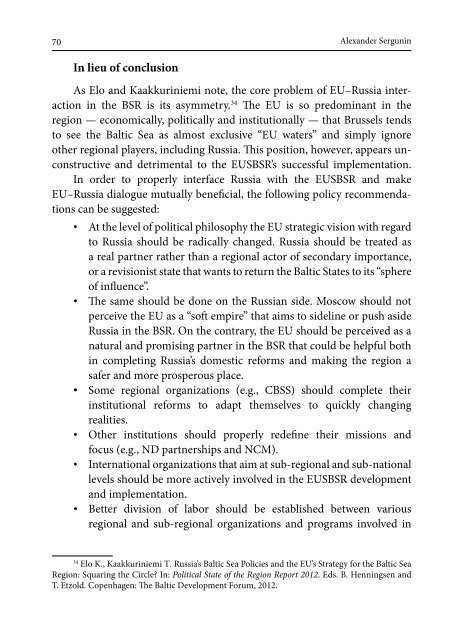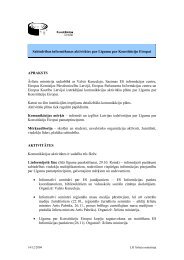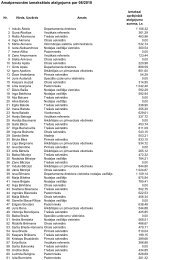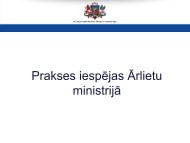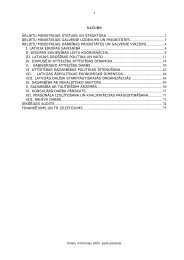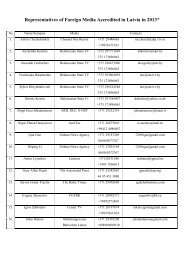Russia and the EU Strategy for the Baltic Sea Region: bridging a (mis)connection gap 69Based on Kaliningrad’s positive experience with the Eurofaculty, theCBSS launched the same project in the Pskov State University in 2009.Under the Russian pr<strong>es</strong>idency the second phase of the Pskov Eurofacultyproject (2012–2015), to develop bachelor and masters programs in economics,finance and law in the PSU, has started. 33 The idea of the projectis to bring the above training programs to the Bologna proc<strong>es</strong>s educationstandards. While St. Petersburg-based universiti<strong>es</strong> are capable of reformingtheir curricula in line with the European standards themse<strong>lv</strong><strong>es</strong>, the Russiannorth-w<strong>es</strong>tern provincial universiti<strong>es</strong> badly need international support andexpertise in this sphere.It should be noted that in Kaliningrad the Eurofaculty project hasgenerated a “spill-over effect” and the idea of <strong>es</strong>tablishing a European LawInstitute at the basis of the Kant Baltic Federal University is being activelydiscussed.At the same time, it should be noted that a number of important longtermCBSS prioriti<strong>es</strong> such as democracy promotion and human rights(except children’s rights) are not the focus of the Russian pr<strong>es</strong>idency. As faras the Russian pr<strong>es</strong>idency’s priority on visa regime liberalization in the BSRis concerned, it is simply irrelevant for the CBSS format, because the Councildo<strong>es</strong> not deal with visa issu<strong>es</strong>. Obviously, this point was picked up fromthe EU-Russian bilateral agenda, where it is normally discussed. Finally,under the Russian pr<strong>es</strong>idency, no proposals on a better division of labor andco ordination between the CBSS and other regional initiativ<strong>es</strong>/programs/institutions, such as EUSBSR, Northern Dimension, HELCOM, BSSSC,UBC, Nordic institutions, etc., have been made Without this institutionalsetting the Russian polici<strong>es</strong> in the BSR look isolated and non-contextual.During its CBSS pr<strong>es</strong>idency Moscow tried to pr<strong>es</strong>ent itself as an emerging“soft power” in the BSR, making the point that Russia no longer pos<strong>es</strong>any military security threat to the countri<strong>es</strong> of the region. On the contrary, ittried to project an image of a r<strong>es</strong>ponsible and attractive regional actor thatcan offer mutually beneficial economic, r<strong>es</strong>earch, educational and culturalprojects to other BSR countri<strong>es</strong>. Whether th<strong>es</strong>e new Russian polici<strong>es</strong> areefficient or not remains to be seen in the near future, although some concernson Russia’s role as a “soft power” in the BSR have been already mentioned.33CBSS EuroFaculty Project in Pskov. http://www.cbss-russia.ru/en/projects-eng/eurofacultypskov.html(Home page of CBSS; visited <strong>10</strong>.05.2013.).
70Alexander SerguninIn lieu of conclusionAs Elo and Kaakkuriniemi note, the core problem of EU–Russia interactionin the BSR is its asymmetry. 34 The EU is so predominant in theregion — economically, politically and institutionally — that Brussels tendsto see the Baltic Sea as almost exclusive “EU waters” and simply ignoreother regional players, including Russia. This position, however, appears un -constructive and detrimental to the EUSBSR’s succ<strong>es</strong>sful implementation.In order to properly interface Russia with the EUSBSR and makeEU–Russia dialogue mutually beneficial, the following policy recommendationscan be sugg<strong>es</strong>ted:•• At the level of political philosophy the EU strategic vision with regardto Russia should be radically changed. Russia should be treated asa real partner rather than a regional actor of secondary importance,or a revisionist state that wants to return the Baltic Stat<strong>es</strong> to its “sphereof influence”.•• The same should be done on the Russian side. Moscow should notperceive the EU as a “soft empire” that aims to sideline or push asideRussia in the BSR. On the contrary, the EU should be perceived as anatural and promising partner in the BSR that could be helpful bothin completing Russia’s dom<strong>es</strong>tic reforms and making the region asafer and more prosperous place.•• Some regional organizations (e.g., CBSS) should complete theirinstitutional reforms to adapt themse<strong>lv</strong><strong>es</strong> to quickly changingrealiti<strong>es</strong>.•• Other institutions should properly redefine their missions andfocus (e.g., ND partnerships and NCM).•• International organizations that aim at sub-regional and sub-nationallevels should be more actively invo<strong>lv</strong>ed in the EUSBSR developmentand implementation.•• Better division of labor should be <strong>es</strong>tablished between variousregional and sub-regional organizations and programs invo<strong>lv</strong>ed in34Elo K., Kaakkuriniemi T. Russia’s Baltic Sea Polici<strong>es</strong> and the EU’s Strategy for the Baltic SeaRegion: Squaring the Circle? In: Political State of the Region Report 2012. Eds. B. Henningsen andT. Etzold. Copenhagen: The Baltic Development Forum, 2012.


